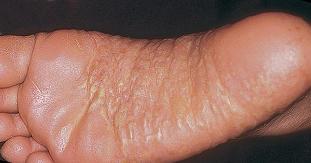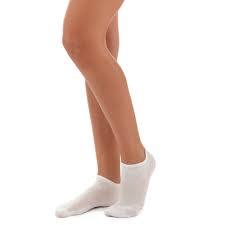Palmar-plantar psoriasis affects the palms of the hands and soles of the feet, but the disease itself represents a pathological autoimmune condition.

Psoriasis on the palms of the hands and feet, along with the localization process on the scalp, is considered to be one of the most common forms of the disease. Accounting for about 14% of the cases of the defective condition of the skin.
The reasons for the development of the disease
Although for Palmar-plantar form of psoriasis is the common bond of age, in the range of 15-35 years has been committed to the highest frequency of the development of the disease. Available and the connection with the ethnic character. It is reported that among persons of caucasian nationality over the age of 50 years significantly increases the risk of developing this pathology.
The exact causes of an unhealthy condition until the end is not clear, and still believed, that the basis of the disease involves an autoimmune process. During normal operation of the immunity a person gets protection from various foreign substances, from viruses, allergens, protozoa and other microorganisms.
With psoriasis occurs a certain disorder in the body, after which the immune system begins to produce aggressive substances against its own cells and tissues. An excessive amount of T-lymphocytes (the main cells of the immune system) and macrophages leads to the development of the inflammatory response and excessive proliferation of the skin cells, such means and leads to the characteristic symptomatology and the formation of hyperkeratosis.
Note! Hyperkeratosis is an excessive thickening of the epidermis — the outer layer of the skin.
Some studies point to a small role of the factor of heredity. For example, about 10% of the population inherits the genes associated with psoriasis and only in 3% of them develops the disease. Similar statistics suggest the idea of the existence of other, more thorough causes of the disease.
Other risk factors are:
- Stress and emotional lability (sensitivity).
- Smoking and drug use.
- On the background of diseases that affect the immune system.
- Infection, frequent injuries and cuts, on the palms and soles of the feet.
In a study from 2006 reported on the relationship of dermatological pathology with diseases of the cardiovascular system and other conditions: hypertension, diabetes mellitus and hyperlipidemia.
The results of the experiments to the end were clear. For a full understanding of all processes, the study of the topic continues and more research is needed.
Triggers the disease (factors that impact on pathology, but not leading to it directly) can be the following:
- Sunburn;
- Insect bites;
- Exposure to allergens;
- Common bacterial infections, such as pneumonia or inflammation of the tonsils;
- Viral diseases, including HIV infection;
- Inflammatory disease of varying severity: bronchitis, inflammation of the nasopharynx;
- Hard alcoholic intoxication;
- Obesity.
Diagnosis of Palmar-plantar psoriasis

Despite the rapid development of modern medicine, in the meantime, the determination of psoriasis on the palms of the hands is possible when the visual examination, the skin doctor without the specialized device. Is based physical examination on "psoriatic triad", is a manifestation of the fact that they are observed when light scrape scales with the affected areas of the body.
The doctor pays attention to the history of the disease, as some constantly accepted medications can be triggers the development of the disease:
- Indomethacin and other nonsteroidal anti-inflammatory agents (NSAIDS);
- Lithium and anti-malaria medications;
- Sharp cancellation corticosteroids;
- The intake of penicillin, hydroxychloroquine.
In awkward cases, it is recommended that a comprehensive examination, which includes laboratory blood tests and ultrasound examination, as well as to eliminate the fungal infection using mycological diagnosis. In the indication to biopsy the dubious mantel of the skin sheets.
Symptoms and first signs of Palmar-plantar psoriasis
Among the main types of the disease there are five variants. While in 90% of cases is observed characterised by the visual clinical picture.
How it looks like Palmar-plantar psoriasis? In the patient on the palms and soles of the feet are designed psoriatic food stamps — red, scaly patches on thickened skin, predisposed to peeling. The house person feels itching, burning and soreness of varying intensity; in some cases, skin veils, cracked and bleeding.
Exerted a considerable influence on the formation of the nails:
- In the nail plate may appear defects, holes;
- The nail thickens and is sterilized;
- It changes its shape.
Palmar-plantar form of the disease arises as a part of the overall process, but is limited only to the skin of the palms and soles of the feet. Psoriasis soles makes it difficult to walk and wear shoes. Damage on the hands can not only disturb you to perform any of the work, but also leave a negative mark on relations with people. Common situations, such as greeting hand, it can be awkward, leading to confusion and social anxiety of man until the development of social phobia.
A distinctive feature of such forms of the disease is the presence of the kinds of processes that can be called in the following terms:
- Palmar-plantar pustular psoriasis of the Barber;
- The festering psoriasis;
- Pustular dermatitis.
Specified disorders of the skin sheets causes the formation of clusters (clusters), the various blisters in the area of the plaques. Overall, this rash is very similar to the normal acne. It is worth noting that this form of the disease is fairly stoically tolerates light treatment and often requires a comprehensive approach to the carried out therapy.
Please note! Pustular psoriasis of the palms and soles of the feet requires the treatment of antibacterial drugs, when you join a bacterial infection.
Phase Palmar-plantar psoriasis

As in all forms of the defective process, Palmar-plantar localization is characterized by three clinical phases:
- The initial phase of the. The appearance of the rash on the hands and feet. Food stamps have a distinctive red hue, may be observed a whitish purulent inclusion; patient tormented by intense itching. The elements of acne coalesce in larger bearings. Their number depends on the individual characteristics of the flow of the disease.
- The stage of stabilization. The condition progresses, new pathological elements are not formed, but the old still intact. The itching will gradually subside, and discoloration of the plaques becomes less clear.
- In the final phase. Accompanied by the use of the elements, the itching is missing. Treatment becomes supportive either excluded at all; provides recommendations for the maintenance of remission and prevention of relapse.
In some cases, the disease is classified for elements of the rash:
- Common form — a typical manifestation of the skin;
- Corner of the form is accompanied by hyperkeratosis and the typical red spots of a few, or are inadequate;
- Form Of Barbera.
Methods of treatment
Palmar — plantar psoriasis is a chronic disease, which may appear repeatedly, regardless of the treatment. However, there are methods and therapies that allow you to achieve a reduction in the timing of deterioration and extending the period of remission.
The main method of treatment is an attempt to prevent the rapid growth of the cellular elements, which lead to the development of plaques, held anti-inflammatory therapy. An alternative technique provides a direct removal of the scales.
Because the skin of the veil on the palms and soles of the feet will thicken even in healthy people, is the treatment of this localization is often assumed to be a combination of methodologies and a more aggressive effect on the bearings.
In the first place with psoriasis of the palms and soles of the feet is hereby appointed as a local treatment in the form of gels, ointments and creams:
- Analogues of vitamin D;
- Ointments based on corticosteroids;
- Retinoids;
- Anthralin;
- Special resin;
- Salicylic acid;
- Moisturizing agent for reducing swelling and easing inflammation.
Common side effects are irritation, drying and thinning of the skin sheets. Moreover, it may be a meeting of phototherapy:
- Natural uv radiation from the sun;
- Artificial uv radiation by using special devices;
- Excimer laser;
- Photochemotherapy.
It is important to know!Very important is a smooth transition to a natural phototherapy. It is recommended to start with 5-10 minutes of direct sun per day. You can then gradually increase the exposure time to 30 seconds per day.
Drugs for the treatment of Palmar-plantar psoriasis
Palmar-plantar psoriasis treatment includes oral medications during the more severe form of the course of the disease:
- Methotrexate;
- Retinoids;
- Cyclosporine;
- Biological drugs, which the activity of the immune system;
- Thioguanine;
- Hydroxyurea.
The most common side effect of these drugs are problems with the gastrointestinal tract.
During the illness and prevention
Heavy course of the disease to some extent can have influence on the development of serious conditions that threaten the health and life of the patient: to 58% increases the risk of myocardial infarction and 43% — at a stroke. The main immediate complications of psoriasis of the palms and soles of the feet is psoriatic arthritis, and dystrophy of the nails.
National medical research center called the variety of diseases that can depend on the skin pathology of:
- Associated autoimmune condition: Crohn's disease, celiac disease, sarcoidosis and more;
- Eye disease: cataract and glaucoma, and infectious processes;
- Increased blood pressure;
- Parkinson's Disease;
- Diabetes mellitus;
- Diseases of the liver and kidneys;
- Osteoporosis;
- Depression.
On that note.Thanks to the treatment and compliance with the necessary recommendations, the possible recurrence of psoriasis it is possible to reduce, and skin manifestations of minimize.
Recommended preventive measures:

- Take your daily baths with natural oils, salts and soap, not that contain artificial flavors and dyes;
- Use a moisturizing cream for the skin (in severe cases — twice a day), and especially after the adoption of water treatments. Is not allowed the use of the solid towels. Simply attach to the skin, soft dry cloth, then use the cream;
- Get sufficient amount of sunlight. It is necessary to consult with a doctor and choose the "golden middle way". Too weak to sunlight will not have a noticeable effect, but too intense — it will increase the risk of skin cancer;
- Avoid triggers, such as smoking, drinking alcohol, stress and infection;
- Use the juice of aloe. It is necessary to carry out the aids to the damaged areas of the skin several times a day. There are official studies that prove the effectiveness of this plant in the fight with inflammatory processes of the skin;
- Have fun no less than three grams of omega-3 fatty acids a day. Include in the diet of fish, walnuts, flaxseed oil, or take fish oil capsules. Fatty acids allow to reduce inflammation in the body;
- It helps to use some special accessories on the basis of barberry, tea tree oil and Dead sea salt.























